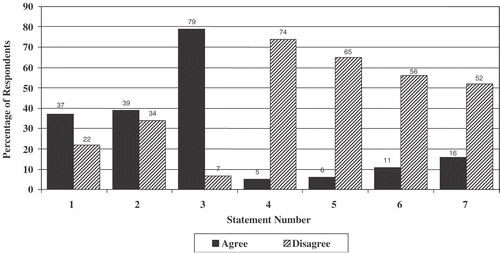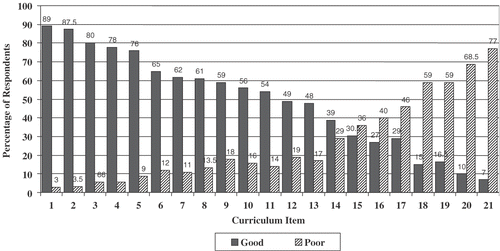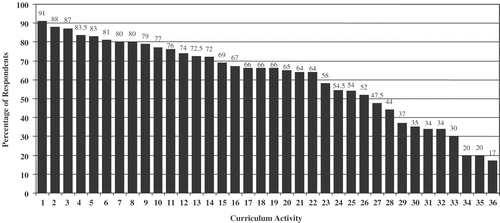Figures & data
Figure 1. Items evaluating the preclinical years: respondents’ ratings of ‘agree’ and ‘disagree’ (†) for the following statements. Key to statement number 1. Basic science courses provided relevant preparation for clerkships* 2. Basic science courses had too many frontal lectures 3. Clinical experiences should be part of the preclinical years¶ 4. Basic science courses included enough simulations (79% vs. 66%, p = 0.012)§ 5. Basic science courses had sufficient illustrations (76% vs. 50%, p = 0.000)§ 6. Basic science courses emphasized clinical relevance adequately (67% vs. 41%, p = 0.000)§ 7. Basic science courses developed or sharpened problem-solving skills (60% vs. 40%, p = 0.001)§ Notes: †Ratings of ‘agree’ are ‘agree’ and ‘strongly agree’ combined, and ratings of ‘disagree’ are ‘disagree’ and ‘strongly disagree’ combined. ‘Partially agree’ omitted. Unless otherwise stated this applies for all graphs. *Significantly more graduates agreed with this statement than students (52% vs. 27%, p = 0.000). ¶Significantly more respondents with an MD degree agreed with this statement than respondents with a joint degree (81% vs. 65%, p = 0.005). §Significantly more students disagreed with these statements than graduates; percentages are shown in parentheses next to the statements.

Figure 2. Evaluation of basic science courses for preparation for work in the clinical setting: respondents’ ratings of ‘good’ or ‘poor’ (†) when asked how well instruction in the following basic sciences courses prepared them for clinical clerkships (as a student) or clinical work (as a physician). Key to curriculum item 1. Anatomy 2. Physiology 3. Pharmacology 4. Pathology* 5. Microbiology 6. Neuroscience§ 7. Histology 8. Metabolism 9. Immunology 10. Genetics 11. Developmental science 12. Biology¶ 13. Biochemistry¶ 14. Embryology 15. Pathopsychology 16. Statistics¶ 17. Computers¶ 18. Medical law 19. Community medicine# 20. General & organic chemistry¶ 21. Physics¶ Notes: †Ratings of ‘good’ are ‘good’ and ‘very good’ combined, ratings of ‘poor’ are ‘poor’ and ‘very poor’ combined, ratings of ‘fair’ omitted. *Significantly more graduates thought that teaching of pathology prepared them well for work in the clinical setting than did students (85% vs. 72%, p = 0.014). §Significantly more students thought that teaching of neuroscience prepared them for work in the clinical setting than did graduates (73% vs. 54%, p = 0.001). ¶Significantly more respondents with a joint degree thought that teaching the above courses prepared them for work in the clinical setting than respondents with an MD degree (p < 0.046). # Significantly more graduates working in a small hospital thought that community medicine course prepared them for clinical practice than graduates working in a large hospital (40% vs. 14%, p = 0.003).

Figure 3. Evaluation of clinical clerkships: percentage of respondents answering ‘agree’ or ‘disagree’ on 11 items concerning the quality of their educational experience during clinical clerkships. Key to statement numbers 1. The number of patient experiences in clerkships was appropriate* 2. The diversity of patient experiences in clerkships was appropriate* 3. Attending faculty demonstrated use of current EBM in patient care 4. Students were expected to demonstrate the use of EBM in patient care# 5. Attending faculty were involved adequately in teaching and evaluating during clerkship¶ 6. Residents played an appropriate role in teaching and evaluation during clerkships 7. Students were given an appropriate role in patient care during clerkships* 8. There was sufficient use of simulations during clerkships 9. Students were given timely feedback on performance in clerkships 10. Bio-ethical issues were discussed during clerkships 11. Students were taught sufficient clinical skills in preparation for clinical practice as physicians Notes: *Significant difference between graduates and students, students tended to be more dissatisfied (p < 0.005). ¶Significantly more respondents with joint degrees agreed with this statement than respondents with MD degrees (63% vs. 55%, p = 0.049). #Significantly more graduates working at a large hospital agreed with this statement than graduates working at a small hospital (61% vs. 38%, p = 0.029).

Figure 4. Deficiencies in the curriculum during clinical clerkships: percentage of respondents reporting that the amount of time devoted to different curricular activities was inadequate. Key to curriculum activity 1. Carrying out invasive diagnostic procedures (CVP etc.) 2. Complementary and alternative medicine 3. Family/domestic violence 4. Clinical pharmacology* 5. Cultural differences and health-related behaviors 6. Care of ambulatory patients in the community 7. Teamwork with other health professionals 8. Occupational medicine* 9. Drug and alcohol abuse 10. Pain management# 11. Long-term healthcare§ 12. Public health and community medicine 13. Palliative care§ 14. Health promotion and disease prevention 15. Students’ involvement in clinical decision-making* 16. Communication skills 17. Diagnosis and management of medical emergencies*¶ 18. Primary care* 19. Care of ambulatory patients in the hospital§ 20. Patient follow-up 21. Psychosocial aspects of diseases 22. Behavioral sciences* 23. Physician–patient relationship 24. Medical genetics and genetic counseling 25. Clinical epidemiology and biostatistics 26. Screening for disease 27. Interpretation of laboratory results*# 28. Evidence-based medicine 29. Geriatrics 30. Medical law 31. Patient interviewing skills* 32. Physical examination* 33. Management of disease 34. Diagnosis of disease* 35. Differential diagnosis* 36. Care of hospitalized patients Notes: *Significantly more students than graduates reported ‘inadequate’ in these curriculum items (p < 0.040). §Significantly more graduates than students reported ‘inadequate’ in these curriculum items (p < 0.050). ¶Significantly more respondents with MD degree reported ‘inadequate’ than respondents with joint degree (for item 2: 89% vs. 83%, p = 0.013; for item 17: 69% vs. 48%, p = 0.010). #Significantly more graduates working at a large hospital reported ‘inadequate’ in these curriculum items than graduates working at a small hospital (for item 10: 89% vs. 70% p = 0.006; for item 27: 43% vs. 26%, p = 0.004).

Figure 5. Percentage of respondents reporting ‘agree’ or ‘disagree’ in respect of the following statements regarding overall assessment, preparedness and research. Key to statement numbers 1. I’m confident that I have the appropriate skills and knowledge to carry out reasonably sophisticated searches of medical information databases* 2. Overall I’m satisfied with the self-learning skills I’ve acquired during my medical education* 3. Overall I’m satisfied with the quality of my medical education* 4. The fundamental knowledge, skills, attitudes and values that medical students should possess at the time of graduation were made explicitly clear to students at my medical school* 5. Students only—I’m confident that I have acquired the clinical skills required to begin an internship program 6. Interns only—I’m confident that I have acquired the clinical skills required to begin a residency program 7. Residents only—I’m confident that I have acquired the clinical skills required to work as a physician 8. I’m confident that I have the appropriate skills and knowledge to conduct research*¶ 9. I’m confident that I have the appropriate skills and knowledge to use a statistical software package (e.g. SPSS etc.)* Notes: *Significantly more graduates agreed with this statement than students, p = 0.000. ¶Significantly more respondents with a joint degree agreed with this statement than respondents with an MD degree (57% vs. 20%, p = 0.000).
